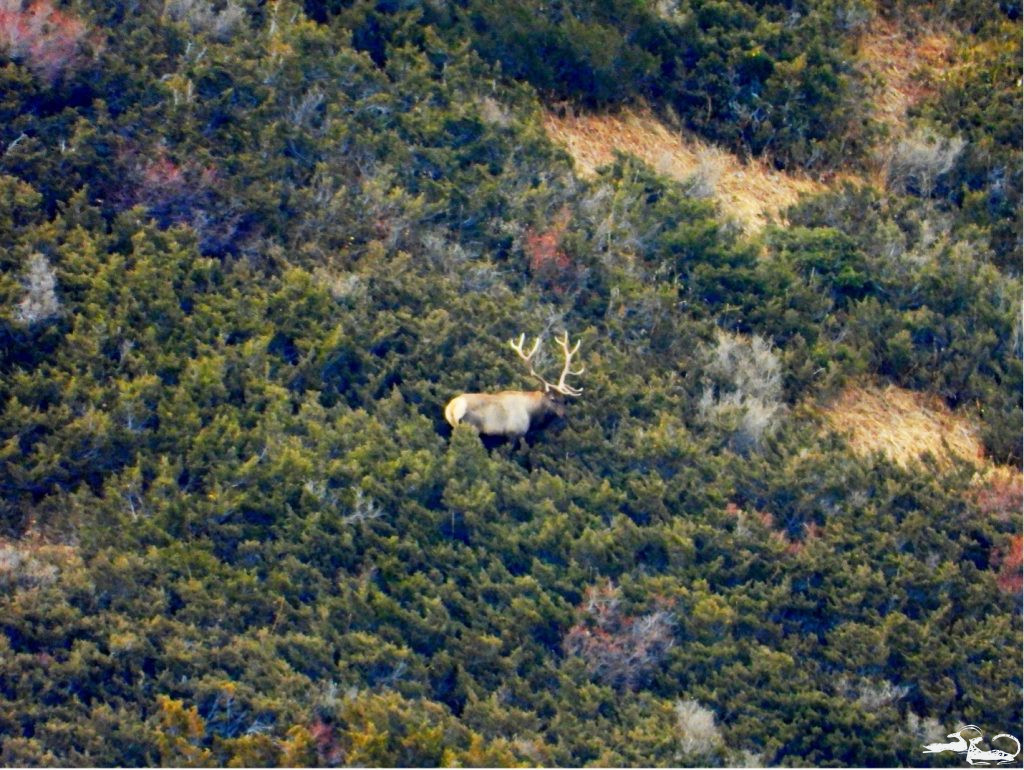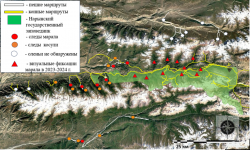
An article was published on the #CAMCAproject website on Tien-Shan maral research in Kyrgyzstan
Link to the article. To assess the current distribution and population size of one of CAMCA’s 6 flagship mountain species, the Tien Shan Maral, Ilbirs Foundation introduced a new monitoring method in Kyrgyzstan, using visual observation from fixed points combined with monitoring bugling or roaring males (a sound made by bulls during the rut). The survey took place from October 7 to 12, 2024, covering the Naryn State Nature Reserve, Salkyn-Tör State Nature Park, and adjacent areas where maral has been previously recorded.
The maral has a vast range, spanning the Tien Shan, Dzungarian Alatau, Tarbagatai, Saur, Altai, and Sayan Mountains across Kazakhstan, Kyrgyzstan, and Russia, as well as Northern Xinjiang and Mongolia up to the Greater Khingan Range. For many years, European and North African red deer, Bukhara deer, East Asian maral, Siberian wapiti, and North American elk were considered a single species, Cervus elaphus. However, based on genetic research conducted in 2004 (by Lundt and colleagues), North American wapiti, maral, and Manchurian wapiti were grouped into a separate species: Cervus canadensis.
The Tien Shan Maral (Cervus canadensis songaricus) is a distinct Central Asian mountain subspecies found in Kyrgyzstan and possibly southeastern Kazakhstan. It is listed as an Endangered (EN C2a(i)) species in Kyrgyzstan’s Red Book. Until the 19th century, the species was widely distributed across spruce forests, but by 1980, it had disappeared from much of this historic range. Today, two isolated populations remain in the Naryn and Issyk-Kul regions.
Previously, the staff of Naryn State Nature Reserve estimated the maral population solely through visual observations. However, given the elusive nature and nocturnal habits of maral, direct observations are rare. So this survey was expanded to include looking for signs such as tracks and droppings, particularly in coniferous forest zones. This first survey was conducted in spring, after the snowmelt but before grass growth exceeded 10 cm. This method increased the likelihood of detecting the presence of maral, as winter droppings—accumulated over the cold months—remained visible.
Taking data from this first survey to inform census efforts, researchers prioritised implementing a second survey in areas where high concentrations of maral tracks were recorded. This second survey was conducted in autumn, with a new methodology that allowed for a more accurate and robust estimate of the population size, not just presence/absence. Observers conducted surveys from 22 designated points during peak activity hours—at dawn (before 9:00 AM) and in the evening (after 3:00 PM). Using binoculars and spotting scopes, researchers recorded the number, sex, and age of individual maral, along with additional details such as distance, azimuth, and terrain characteristics. During this same time, the number of bugling males was estimated based on audio observations.
This new spring/fall combined survey methodology allowed for a more comprehensive and effective assessment. As illustrated in the pie chart, it captured more observations of maral than visual counts alone. Additionally, a conversion factor for bugling males (based on previous literature) was applied during data analysis, further increasing the accuracy of the population estimate.
After completing a trial survey in October 2023 at Naryn State Nature Reserve to assess applicability and effectiveness, Ilbirs Foundation, in collaboration with the National Academy of Sciences and a consultant for UNEP, shepherded the entire process from start to finish in 2024 — developing the methodology, training rangers, and organizing and overseeing all fieldwork, including population counts and data collection.
A total of 160 maral were recorded during the study:
- 121 individuals were observed from monitoring points and
- 39 bugling males were recorded.
Of those observations:
- 39 were adult males
- 13 were young males
- 52 were females
- 11 were calves
- 6 individuals’ sex could not be determined
Using extrapolation methods (accounting for approximately 30% of unexamined habitats) and adjusting for external factors, the current maral population in Naryn River valley and its tributaries is estimated at between 400 and 600 individuals.
The new methodology was also based on tested approaches used for other species in the Kyrgyz Republic, including:
• «The modern methodology for accounting for mountain ungulates, such as argali and Siberian ibex (Ovis ammon, Capra sibirica) in the territory of Kyrgyzstan» (Davletbakov, 2022),
• Methods outlined in the article “Methodology for accounting for red deer” (Cervus elaphus L.) by their calls during rutting» (Zyryanov A.N., 2012).
This instruction was approved by order of the Ministry of Natural Resources, Ecology, and Technical Supervision No. 335 on December 28, 2024.
The findings highlight both the persistence and vulnerability of the Tien Shan Maral population in Kyrgyzstan. While recent conservation efforts have helped stabilize these numbers, continued protection, habitat management, and anti-poaching measures remain critical. By refining monitoring techniques and expanding conservation initiatives, there is hope that the Tien Shan Maral’s range can gradually recover, ensuring the survival of this magnificent species in Central Asia’s mountain landscapes.


